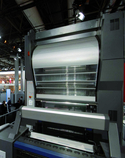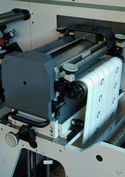The right choice for carton converters
24 August 2010Carton manufacturers are having to offer ‘something different’ in order to compete in today’s competitive marketplace. Nick Coombes looks at some of the options.
In a packaging market currently valued at approximately £100 billion/year, carton converters, who account for around 27% by value, have reason to be optimistic about the growing demand for packaging that uses natural fibres. Recognising this trend, and responding to assist their customers are the printing press manufacturers, who are only too aware that if folding cartons are to be commercially viable, they must offer ‘something different’.
With package print contracts won or lost by a decimal point, price competition is a way of life. The question is, what else do you need to offer? One of the answers has been known and practised for many years by carton converters in America. Brought up on a diet of long runs using web-fed presses, the American carton houses have long enjoyed the benefits of inline processing. The act of converting a blank reel of cartonboard at one end of the press to a finished carton at the other, and at high speed, has been an answer to the question: ‘how do we become more efficient?’.
Jerry Henson, from the Comco Division of Mark Andy, explains: “Everything in American industrial history has been driven by time and money, and the web-fed carton press with inline converting is a prime example. The more processes you can combine in one pass, the better, from flexo, screen, and gravure printing to die cutting and everything in between, like laminating, window punching, hot and cold foiling, and embossing. Comco has more experience in this sphere than any other press manufacturer, having pioneered much of the machine development in the USA with the ProGlide MSP (Multi Substrate Press) series.”
Launched originally in the 1980s, and with more than 30 installations worldwide, the Comco technology has gone on to set a standard for much of the growth in this market with its heavy duty die cassettes that can be changed and tested offline. Waste is another key issue, since the cartonboard is a major cost element. “Rotary one-pass production offers better carton nesting and cuts out the gripper waste that is inherent in sheet-fed offline cartons,” adds Mr Henson.
Marco Calcagni, of Omet, the Italian narrow web press manufacturer that has branched out from labels into the broader packaging market, takes up Mr Henson’s theme. “What inline presses offer is flexibility. Our VaryFlex series has interchangeable flexo, screen, and foil print units, as well as a rotogravure option. Most recently, we have developed UV-offset printing heads, which reduce prepress costs such as plate making, and shorten makeready with sleeve technology. We have also developed two unique die cutting units, Fly Cut and Twin Cut. The former uses a simple scissor action, the latter removes the need for expensive die cylinders. It is all about cutting cost to improve profitability.” Omet has also had success with its inline hologram application security technology.
Whereas flexo was, for many years, considered the poor relation in print quality terms, the advent of UV curing, better inks, anilox rolls, and digital plates has made it a far more level playing field. Jim Dunlop, who represents the Packaging Division of Gallus (formerly BHS), adds: “There are two key advantages offered by the inline flexo process: colour consistency, and better flexibility to handle short run work. Few still argue about the relative quality of UV flexo, and in any case UV offset is available if needed, but it is essentially the ability to respond quickly to a variety of job requirements that is our trump card, from converting in one pass to text changes handled ‘on-the-fly’ at full press speed. I don’t ever see this style of carton production taking over the global market – what I do see is the opportunity it offers existing and start-up carton houses to increase their flexibility and therefore handle more work profitably.”
Mr Dunlop’s comment alludes to a situation, especially in Europe, where sheet-fed offset with offline converting is the norm for carton production, and because it is the heartland of this type of machinery manufacturer, it is a major obstacle to inline progress. Or is it?
Heidelberg UK’s Steve Cavey says: “Packaging has to stand out, to be produced at break neck speed and at a cost that remains competitive while still earning a decent margin. Differentiation by producing more complex results in a single pass through the press is both lean and efficient. It’s well known that ink on paper is not enough because this is the heyday of special effects, of adding value and enhancing the look and feel of the product. That is why our latest carton presses are more versatile than ever. Even the type of ink and how it is applied can create niche products. UV’s cleanliness, drying speed, elimination of powder spray and high gloss results impress and it retains a strong presence in packaging,” he explains.
Coating in carton converting can add significant value. Likewise, use of hologram application, hidden images and rainbow printing is growing, also foiling now that it has become a ‘cold’ process and achieved inline. Heidelberg and manroland both offer inline foil units.
Previously confined to high-end cosmetics, perfumes, and spirits, cold foiling at a lower cost at higher speed has opened new markets, delighting many a brand manager. Still, the inline process does not come cheap, needing two further print units in the press configuration, and the foil unwind and rewind. But foil wastage is limited by indexing that restricts its application to specific print lengths.
Usefully, unlike foil application applied offline, the inline process comes before printing and allows unusual effects to be created by subsequent overprinting. “There is no need for specialist expertise or tools, because experienced press operators will encounter no learning curve with the cold application process and foil can be applied to any stock that the press can handle,” comments manroland UK’s Adam Robotham. “The foiling effect adds considerable value to traditional print, providing a strong return on investment for the printer, and products that clearly differentiate themselves,” he adds.
In sheet-fed carton printing, both Komori and KBA put stress on quality control inline. Komori’s PQA-S (Print Quality Assessment System) was developed for its commercial web presses, but the technology has transferred to its sheet-fed Lithrone series targeting carton houses. Says Steve Turner, of Komori UK: “Our PQA-S inspects sheets through a high definition camera, creating a digital memory of the pass sheet to which every consequent sheet is compared. It detects mis-register, ink, water and oil drops and hickeys”.
At KBA, UK Sales Director Mark Nixon says: “Our long tradition of building carton presses, particularly in the larger formats has convinced us of the need for controlled quality throughout the production run, and we focus on reducing the risk of error.”
Plate-Ident, which ensures each unit has the correct plate the right way round and pre-registers it before the first pull, along with DriveTronic SPC, which allows simultaneous plate changing in 60secs irrespective of the number of print units involved, are two of KBA’s latest control systems.
Heidelberg’s FoilStar unit can add ‘shelf appeal’ by creating eye-catching effects. Heidelberg Comco’s gravure unit (left); and built into a flexo line. Comco Komori’s PQA-S system was developed for its commercial web presses, but the technology has transferred to its sheet-fed Lithrone series. Komori Cold foiling on a manroland press. Manroland Omet’s Mono Twincut unit. Omet External weblinksConverting Today is not responsible for the content of external internet sites.Comco Omet Gallus Heidelberg Manroland Komori KBA






